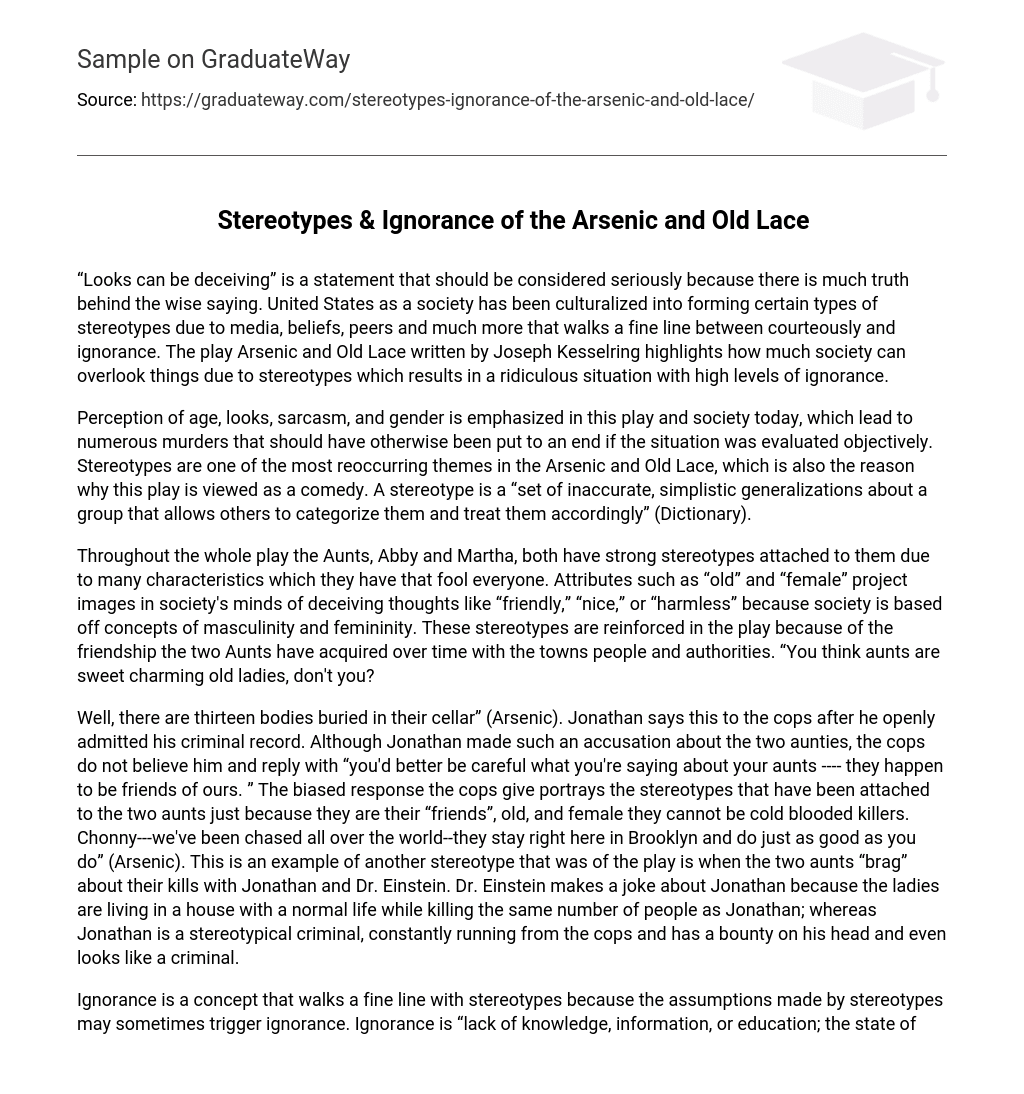“Looks can be deceiving” is a thought-provoking statement that holds much truth. American society has absorbed various stereotypes through media, beliefs, and social interactions, often blurring the line between politeness and ignorance. Joseph Kesselring’s play, Arsenic and Old Lace, brilliantly exposes society’s tendency to overlook certain aspects due to preconceived notions, leading to absurd situations and high levels of ignorance.
In this play and in modern society, the emphasis is placed on how age, appearance, sarcasm, and gender are perceived. Unfortunately, this emphasis has led to multiple murders that could have been prevented if the situation had been evaluated impartially. The play Arsenic and Old Lace frequently explores stereotypes, which is why it is considered a comedy. Stereotypes are characterized by the use of inaccurate and oversimplified generalizations about a particular group. This allows others to categorize and treat individuals based on these stereotypes (Dictionary).
The Aunts, Abby and Martha, throughout the play, are associated with various stereotypes due to their traits that deceive people. Society’s perception of the attributes “old” and “female” leads to assumptions of being “friendly,” “nice,” or “harmless” as the society’s framework is built on concepts of masculinity and femininity. These stereotypes are upheld in the play because of the long-standing friendship the Aunts have developed with the townspeople and authorities. “You believe aunts are sweet, charming old ladies, right?
Jonathan openly admits his criminal record and accuses the two aunties of burying thirteen bodies in their cellar. However, the cops do not believe him and warn him to be careful with his accusations, emphasizing that they are friends with the aunts. The biased response of the cops reflects the stereotypes associated with the aunts’ age, gender, and friendship with the police, suggesting they are not capable of being cold-blooded killers. Another stereotype portrayed in the play is when the aunts proudly share their kills with Jonathan and Dr. Einstein. Dr. Einstein mocks Jonathan because the aunts are living normal lives in Brooklyn while having the same body count as him, contrasting Jonathan’s criminal stereotype of being constantly pursued by the police and having a bounty on his head.
Ignorance and stereotypes are closely linked as stereotypes can sometimes lead to ignorance. Ignorance is defined as a lack of knowledge, information, or education, and is characterized by being ignorant. In the play, the two aunts were heavily stereotyped, resulting in the police remaining ignorant and steadfast in their stereotypes despite any accusations made against them.
The play Arsenic portrays various types of ignorance, not just limited to stereotypes, which contributes to the humor in the script. In one scene, Jonathan and Einstein prevent Mortimer from speaking by gagging him with a handkerchief and tying him to a chair using a curtain cord. When questioned about Mortimer’s condition, Einstein explains that it is a result of him trying to explain the play they saw. O’Hara initially tries to remove the gag from Mortimer’s mouth but ultimately decides against it, stating the importance of hearing the plot.
This scene in the play exemplifies ignorance as Mortimer is tied down and gagged, yet the gullible officer remains oblivious due to his self-absorption with his own play. This kind of ignorance stems from sheer stupidity and is so absurd that it becomes comical for the audience. “Brophy: He was trying to get us down in the cellar. Klein: He said there was thirteen bodies buried down there. Rooney: [suspicious] Thirteen bodies buried in the cellar? [Deciding it’s ridiculous] And that didn’t tip you off he came out of a nut -house! (Arsenic)” This scene demonstrates how stereotypes can lead to uninformed decisions. Following Jonathan’s assault on Officer Klein, the officers engage in this conversation.
Ultimately, the officers considered the statement of thirteen dead bodies in the cellar as ridiculous, coming from a killer who resembled Frankenstein. This stereotype led them to believe that the statement was untrue and merely a ploy to ensnare them. The conversation between Rooney and Abby reveals that there are indeed thirteen bodies in their cellar, specifically due to arsenic poisoning. The officers’ perception was shaped by stereotypes, causing them to overlook the possibility of there actually being thirteen bodies in the cellar. They dismissed the aunts’ admissions as a joke because they couldn’t fathom that the aunts themselves could be killers. This situation exemplifies ignorance or obliviousness when even the killers’ own confessions fail to be believed.
The cellar was never inspected to verify Jonathan’s truthful claim. Stereotypes and ignorance are prevalent in society, and the terms can be almost interchangeable. The movie presents extreme instances of how these stereotypes can breed ignorance, using satire to appear preposterous and amusing to viewers. Despite the comedic nature of the play, Kesselring aims to portray society’s obliviousness and ignorance. Following this performance, society will hopefully be enlightened to “not judge a book by its cover.”





